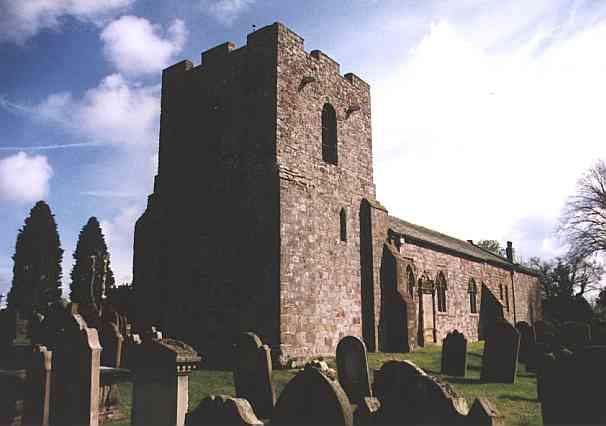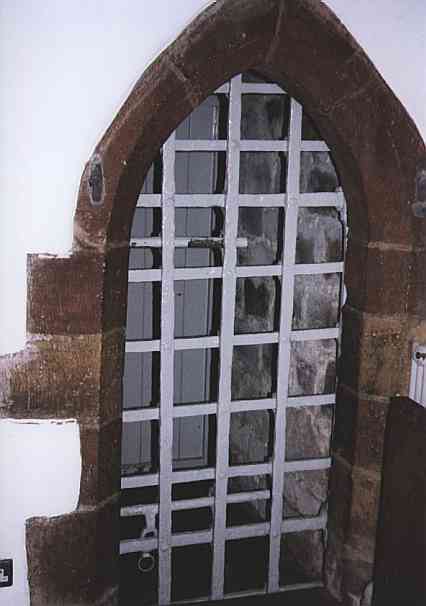 Burgh-Upon-Sands, or Burgh-by-Sands, is an ancient village,
delightfully situated on the north bank of the canal, in the township of Burgh Head and
West End, 5 miles W. by N. of Carlisle, and near the site of the great Roman wall, where
there are still traces of the station of Axelodunum3.
The township contains 1575 acres of land, rated at £2141 6s. 6d., the property of Miss
Matthews, G.H. Oliphant Esq., the earl of Lonsdale, Mrs. Hodgson, Messrs. John Hodgson,
John Hewson and several resident freeholders. On Burgh Marsh, about a mile N. of the
village a monument commemorating the death of Edward I, who died here in 1307, was erected
by Henry, duke of Norfolk, in 1685; but it having gone to decay, another was erected by
the late Earl of Lonsdale, in 1803, with an appropriate Latin inscription. Camden was
informed that, in the very estuary of Solway Frith4,
"there was a fight between the Scotch and English, and that when the tide came in,
the dispute was managed by the horse."
Burgh-Upon-Sands, or Burgh-by-Sands, is an ancient village,
delightfully situated on the north bank of the canal, in the township of Burgh Head and
West End, 5 miles W. by N. of Carlisle, and near the site of the great Roman wall, where
there are still traces of the station of Axelodunum3.
The township contains 1575 acres of land, rated at £2141 6s. 6d., the property of Miss
Matthews, G.H. Oliphant Esq., the earl of Lonsdale, Mrs. Hodgson, Messrs. John Hodgson,
John Hewson and several resident freeholders. On Burgh Marsh, about a mile N. of the
village a monument commemorating the death of Edward I, who died here in 1307, was erected
by Henry, duke of Norfolk, in 1685; but it having gone to decay, another was erected by
the late Earl of Lonsdale, in 1803, with an appropriate Latin inscription. Camden was
informed that, in the very estuary of Solway Frith4,
"there was a fight between the Scotch and English, and that when the tide came in,
the dispute was managed by the horse."
The parish church, dedicated to St. Michael, is very
ancient, but has undergone several alterations. The north entrance is of the Saxon style
of architecture; and the immense embattled tower is only entered from the church by a
ponderous iron door, 6 feet 8 inches in height, with two large iron bolts. This tower, the
walls of which are seven feet thick, is supposed to have been built in the reign of Edward I, and
was evidently a place of security during the border wars. The benefice is a
vicarage,† in the patronage of the crown, and incumbency of the Rev. John Lowry. In
1535, the living was only estimated at £5 1s. 11¼d., but was certified to the governors
of queen Anne's bounty at £13 8s.; after which it was augmented, in 1758, by Joseph
Liddell, and queen Ann's bounty, with £400, with which land was purchased. In 1843, the
ecclesiastical commissioners granted to it £30, and in the same year the tithes were
commuted for a yearly rent charge of £23; so that the vicarage is now worth about £120
per annum. The rectorial tithes, which formerly belonged to a number of lay impropriators,
were redeemed by the landowners, in 1829, except that portion belonging to Dovenby school,
which was also purchased by the proprietors of the soil, in 1846, for the sum of £500, so
that the whole is now merged in the land. There was a respectable Grammar School here, up
to the year 1786, after which it was converted to his own use by the succeeding vicar, but
the house is now neatly fitted up and used as a vestry, in which the parish meetings are
held. The parishioners subsequently erected another school, on West End Green, to which
they appoint a master, who receives £1 18s. 6d. a year from one of the charities
belonging to this parish.
feet thick, is supposed to have been built in the reign of Edward I, and
was evidently a place of security during the border wars. The benefice is a
vicarage,† in the patronage of the crown, and incumbency of the Rev. John Lowry. In
1535, the living was only estimated at £5 1s. 11¼d., but was certified to the governors
of queen Anne's bounty at £13 8s.; after which it was augmented, in 1758, by Joseph
Liddell, and queen Ann's bounty, with £400, with which land was purchased. In 1843, the
ecclesiastical commissioners granted to it £30, and in the same year the tithes were
commuted for a yearly rent charge of £23; so that the vicarage is now worth about £120
per annum. The rectorial tithes, which formerly belonged to a number of lay impropriators,
were redeemed by the landowners, in 1829, except that portion belonging to Dovenby school,
which was also purchased by the proprietors of the soil, in 1846, for the sum of £500, so
that the whole is now merged in the land. There was a respectable Grammar School here, up
to the year 1786, after which it was converted to his own use by the succeeding vicar, but
the house is now neatly fitted up and used as a vestry, in which the parish meetings are
held. The parishioners subsequently erected another school, on West End Green, to which
they appoint a master, who receives £1 18s. 6d. a year from one of the charities
belonging to this parish.
Boustead Hill township has a small village on the south side of the canal, overlooking the Solway Frith, two miles west of Burgh. The township contains 554 acres of fertile land, chiefly the property of Messrs. W. Simpson, W. Nixon, and J. Morton: it is rated at £624 18s.
Long Burgh is a village and township on the south side of the canal, one mile west of Burgh. It also includes the hamlet of Dykesfield, on the opposite bank, long the seat and property of the family of Dykes, who removed hence to Dovenby. Dykesfield is now the property of Mr. John Hodgson. The township contains 612 acres of excellent land, and the other principal owners are G.H. Oliphant Esq., Messrs. Robert Hodgson, Samuel Blaylock, and Thos. Robinson: it is rated at £857 17s.
Moorhouse, a pleasant village and township, two miles south of Burgh, and four miles west of Carlisle, contains 1280 acres, rated at £1168 10s. The principal land owners are Major Ewart, Messrs. Andrew Green, Wm. Stordy, and John and Joseph Ostell. Moorhouse Hall is a commodious mansion, the property of Major Ewart, and residence of John Forster, Esq. The school, at Moorhouse, receives £1 18s. 6d. from Pattinson's charity, for which two children receive gratuitous instruction. Here is a Friend's Meeting House, at which a respectable congregation attends. Thomas Stordy, who died in 1684, and Jonathan Ostell, who died in 1755, were natives of the parish of Burgh, and distinguished themselves as pious and industrious preachers amongst the peoples called Quakers, and being by law entitled to the impropriation of certain tithes, they demised them to the several owners on whose estates they arose. Mr. Stordy suffered many persecutions for his religion. Being at Carlisle assizes, in 1662, he went to visit some of his friends then imprisoned there, when he was illegally detained by the gaoler, and next day carried before the court. On his refusing to take the oath of allegiance there tendered to him, he was immediately sent back to the prison, and next day had the sentence of premunire passed upon him, which was a forfeiture of all his real and personal estate. In consequence of this sentence, he was kept a close prisoner at Carlisle for ten years, but was at length released by the king, in 1672, and his real estate restored to him through the intercession of the earl of Carlisle. A few years afterwards he was prosecuted under the obsolete statute of 23rd of Elizabeth, for £20 a month, for absenting himself from the public worship, and again cast into prison, where he died in 1684. Thurstonfield5 is another village in this township, one mile west of Moorhouse. Here is a tannery; and in the township are three corn mills. The commons, about 52 acres, were enclosed by mutual consent, in 1842.
* Burgh Head and West End were formerly two townships, but owing to the difficulty of defining the boundaries, are now united.
† The church, which was anciently rectorial, was granted by Sir Hugh de Morvil, one of the lords of the barony of Burgh, to the abbey of Holme Cultram (which grant was confirmed by Pope Innocent III), for the use of the poor and support of the chaplain of that house. He was one of the four ruthless assassins who murdered St. Thomas à Beckett, while at his devotions; after which, says Mr. Denton, "he came to great misery;" and the same writer adds, that "the sword that killed St. Thomas was at Ishall in his father's time, and since remaineth with the house of Arundel." Near the church were discovered, a few years ago, some foundations, supposed to be those of the ancient baronial mansion; near to it is a field still designated "spill-blood holme," and, until very lately, an old ash tree stood here, called "hangman's tree," on which, it is presumed, many victims of those feudal lords were executed.
Mannix & Whellan, History, Gazetteer and Directory of Cumberland, 1847